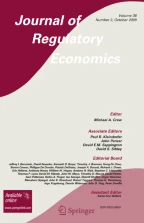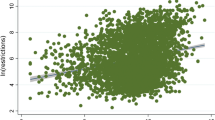Regulating away competition: the effect of regulation on entrepreneurship and employment

Many scholars have worried that regulation deters entrepreneurship because it increases the cost of entry, reduces innovation in the regulated industry, and benefits large firms because they can overcome the costs of complying with regulations more easily than smaller firms. Using novel data on the extent of US federal regulations by industry and data on firm births and employment from the Statistics of US Businesses, we run fixed effects regressions to show that more-regulated industries experienced fewer new firm births and slower employment growth in the period 1998–2011. Large firms may even successfully lobby government officials to increase regulations to raise their smaller rivals’ costs. We also find that regulations inhibit employment growth in all firms and that large firms are less likely to exit a heavily regulated industry than small firms.
This is a preview of subscription content, log in via an institution to check access.
Subscribe and save
Springer+ Basic
€32.70 /Month
- Get 10 units per month
- Download Article/Chapter or eBook
- 1 Unit = 1 Article or 1 Chapter
- Cancel anytime
Buy Now
Price includes VAT (France)
Instant access to the full article PDF.
Rent this article via DeepDyve
Similar content being viewed by others

Regulation, entrepreneurship, and firm size
Article 11 April 2022

One size fits all? The differential impact of federal regulation on early-stage entrepreneurial activity across US states
Article 14 February 2023

Industry size and regulation: Evidence from US states
Article 15 April 2022
Notes
More broadly, the literature on the relationship between institutional quality and economic growth suggests that countries with better institutions and greater levels of economic growth often have less burdensome regulatory institutions (Hall and Jones 1999; Acemoglu et al. 2001; Djankov et al. 2006). Countries that have better institutions (open access to political power, greater constraints on the executive, and greater political rights) tend to have less burdensome regulation and, as a result, tend to perform better in terms of economic growth (Djankov et al. 2002).
Economists have long argued that incumbents may pursue such regulation of entry deliberately to protect themselves from competition by new entrants (Tullock 1967; Stigler 1971; Peltzman 1976).
Maloney and McCormick (1982) show for the example of cotton dust regulation that such regulation benefited producers with a larger fraction of cotton used by the firms in their production process. Their evidence suggests that regulation specific factors other than firm size may determine the distribution of regulatory rents within the industry.
We do not include many control variables we would prefer to because they are observed only at the national level (not the industry level) each year, they are perfectly collinear with year dummies; including them in a regression together with year dummies causes some variables to be dropped. Thus, we use year dummies as our only national-level controls in the regressions reported in the body of the paper. Unreported regressions using the macroeconomic controls plus a linear time trend instead of year dummies show results that are nearly indistinguishable our main results.
While our results for the effect of regulation on firm birth and employment growth of large firms are not statistically significant in any of our specifications, they are of a greater magnitude than the results for small firms, which are all statistically significant.
References
- Acemoglu, D., Johnson, S., & Robinson, J. (2001). The colonial origins of comparative development: An empirical investigation. American Economic Review, 91(5), 1369–1401. ArticleGoogle Scholar
- Al-Ubaydli, O., & McLaughlin, P. A. (2014). RegData: A numerical database on industry-specific regulations for all U.S. Industries and Federal Regulations, 1997–2012. Mercatus Center Working Paper No. 12-20 .
- Barrett, S. (1991). Environmental regulation for competitive advantage. Business Strategy Review, 2(1), 1–15. ArticleGoogle Scholar
- Barrett, S. (1992). Strategy and the environment. Columbia Journal of World Business, 27(3&4), 202–208. Google Scholar
- Birnbaum, P. H. (1984). The choice of strategic alternatives under increasing regulation in high technology companies. Academy of Management Journal, 27(3), 489–510. ArticleGoogle Scholar
- Bjornskov, C., & Foss, N. J. (2008). Economic freedom and entrpreneurial activity: Some cross-country evidence. Public Choice, 134(3/4), 307–328. ArticleGoogle Scholar
- Branstetter, L., Lima, F., Taylor, L. J., & Venancio, A. (2013). Do entry regulations deter entrepreneurship and job creation? Evidence from recent reforms in portugal. The Economic Journal, 124(June), 805–832. Google Scholar
- Brock, W. A., & Evans D. S. (1989). Small business economics. Small Business Ecnomics, 1(1), 7–20.
- Calcagno, P. T., & Sobel, R. S. (2013). Regulatory costs on entrepreneurship and establishment employment size. Small Business Economics, 41(1), 541–240.
- Coffey, B., McLaughlin, P. A., & Tollison, R. (2012). Regulators and redskins. Public Choice, 153, 191–204. ArticleGoogle Scholar
- Coffey B., McLaughlin P. A., & Peretto P. (2016). The cumulative cost of regulations. Mercatus working paper. Mercatus Center at George Mason University.
- Dawson, J., & Seater, J. (2013). Federal regulation and aggregate ecnomic growth. Journal of Economic Growth, 18, 137–177. ArticleGoogle Scholar
- Dean, T. J., & Brown, R. L. (1995). Pollution regulation as a barrier to new firm entry: Initial evidence and implications for future research. Academy of Managment Journal, 38(1), 288–303. ArticleGoogle Scholar
- Djankov, S., La Porta, R., Lopez-de-Silanes, F., & Shleifer, A. (2002). The regulation of entry. The Quarterly Journal of Economics, 117(1), 1–37. ArticleGoogle Scholar
- Djankov, S., McLiesh, C., & Ramalho, R. M. (2006). Regulation and growth. Economics Letters, 92, 395–401. ArticleGoogle Scholar
- Hall, R., & Jones, C. (1999). Why do some countries produce so much more output per worker than others? Quarterly Journal of Economics, 144(1), 83–116. ArticleGoogle Scholar
- Helland, E., & Matsuno, M. (2003). Pollution abatment as a barrier to entry. Journal of Regulatory Economics, 24(2), 243–259. ArticleGoogle Scholar
- Klapper, L., Laeven, L., & Raghuram, R. (2006). Entry regulation as a barrier to entrepreneurship. Journal of Financial Economics, 82, 591–629. ArticleGoogle Scholar
- Maloney, M. T., & McCormick, R. E. (1982). A positive theory of environmental quality regulation. Journal of Law and Economics, 25(1), 99–123. ArticleGoogle Scholar
- Mulligan, C., & Shleifer A. (2005). Conscription as regulation. American Law and Economics Review, 7(1), 85–111.
- Nystrom, K. (2008). The institutions of economic freedom and entrepreneurship: Evidence from panel data. Public Choice, 136(3/4), 269–282. ArticleGoogle Scholar
- Pashigian, B. (1984). The effect of environmental regulation on optimal plant size and factor shares. Journal of Law and Economics, 27, 1–28. ArticleGoogle Scholar
- Peltzman, S. (1976). Toward a more general theory of regulation. The Journal of Law and Economics, 19(2), 211–240.
- Pigou, A. (1938). The economics of welfare. London: McMillan. Google Scholar
- Sobel, R. S., Clark, J., & Lee, D. R. (2007). Freedom, barriers to entry, entrepreneurship, and economic progress. Review of Austrian Economics, 20, 221–236. ArticleGoogle Scholar
- Stigler, G. J. (1971). The theory of economic regulation. The Bell Journal of Eocnomics and Managment Science, 2(1), 3–21. Google Scholar
- Thomas, L. G. (1990). Regulation and FIrm Size: FDA impacts on innovation. The Rand Journal of Economics, 21(4), 497–517. ArticleGoogle Scholar
- Tullock, G. (1967). The welfare costs of tarriffs, monopolies, and theft. Western Economic Journal, 7, 224–232. Google Scholar
Author information
Authors and Affiliations
- Department of Economics, Providence College, 1 Cunningham Square, Providence, RI, 02918, USA James B. Bailey
- Department of Economics and Finance, Heider College of Business, Creighton University, 2500 California Plaza, Omaha, NE, 68178, USA Diana W. Thomas
- James B. Bailey




